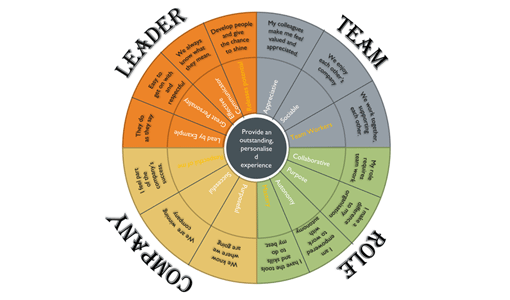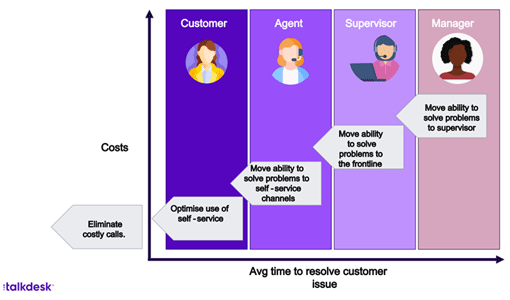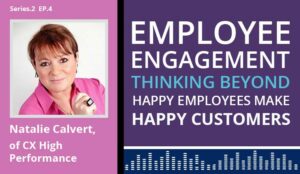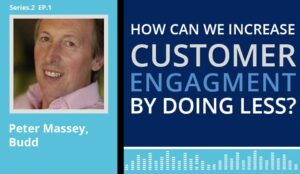Want to reduce agent absenteeism and turnover? Here are some tips to help you drive positive change…
Why Do I Need to Improve my Workforce Engagement Strategy?
Agent absenteeism and turnover can result in higher costs. Not only that, but agent performance can directly impact customer satisfaction, loyalty, and ultimately revenue.
To maximize talent investments and maintain exceptional CX, organizations must rethink their workforce engagement strategies and the role of the agent in the contact centre.
That’s why we’ve put together these experts’ top tips on getting it right.
Top Tips for Improving Your Workforce Engagement Strategy
Delegate Decisions Instead of Tasks
Stop telling people what to do! The way we communicate to people matters.
We can apply this to everyday conversations by really delegating decisions (and opportunities for decisions) – instead of just delegating information, cascading information, or just giving tasks out to people.
For example, a manager could say; “We have optimized your breaks, please adhere to your schedules” – a conversation that happens every day in call centres all around the world OR they can choose to rephrase this to say; “Here are the best times to take breaks, work with your team to decide who’s going and when”.
Stop telling people what to do! The way we communicate to people matters.
This latter approach moves some of the decision-making to the frontline, meaning all of a sudden, they need to listen and pay attention to the information you’re sharing.
Empower Agents During Coaching Sessions
This approach also applies to coaching techniques, as if you empower the person that you’re coaching to decide and choose what they’re going to commit to, it makes them feel like they’re contributing to that decision.
For example, saying; “What do you want to focus on next to help you increase your bonus?” is far more powerful and effective than outright telling them that they need to improve their Average Handling Time (AHT). Leaving that little room for choice is important.
Overall, there are clear benefits of delegating decisions rather than tasks. You get the higher commitment to the outcomes that you’re aiming for, you build a sense of purpose in the participation by your attention to the information that you’re sharing.
Then you also continue to develop your participants, you teach them how to think, you teach them how to digest that information and use it for decision-making. That’s especially great if we’re developing leaders or the analysts of the future.
Looking for information on empowering your contact centre staff, read our article: What Does Employee Empowerment REALLY Mean?
Differentiate Between a ‘Fixed’ and ‘Growth’ Mindset
The basic idea behind the growth mindset – based on a book by Dr Carol S. Dweck – is that in most situations you either have a ‘fixed mindset’ or a ‘growth mindset’.
A good way to explain this is to think about mindsets towards intelligence:
| A Fixed Mindset | A Growth Mindset |
|---|---|
|
If you believe that intelligence is fixed, you probably also think that natural talent defines what you can do, that it’s a symbol of that higher ability in that field of intelligence. It means you’re good at something, it comes easy to you, it demonstrates talent. The scary part of this is that when you start failing at something, you feel you’ve peaked and hit a limit, and from here on in, everything is above you. |
By contrast, if you have a growth mindset about intelligence, there’s a base belief that intelligence can grow. An “I can’t do it now, but if I apply myself, I can grow” thought-process that natural talent is only a head start. You believe that the point at which you struggle to do something, that’s the point from which you start to learn. This is fundamental in setting ourselves up for engagement in a workplace that’s evolving, that’s trying to change its outcome and improve. |
Why Does it Matter so Much?
People with a growth mindset will be more resilient to the inevitable knocks that change brings with it and the difficulties that people have in meeting new challenges that they couldn’t deal with before.
Stop Reinforcing a Fixed Mindset in Your Team
It’s important that you’re conscious of the bad habits that reinforce a fixed mindset, like these listed below, and do what you can to nip them in the bud:
- Celebrating Results Over Effort Every Day – This happens a lot in the customer service industry. That’s a bit scary because it’s very easy to get good results if you just repeat the same thing. If effort then isn’t valued and celebrated, then it’s difficult to then go and chase new opportunities, as they feel riskier.
- Complimenting Things That Look Easy – We say to people “you make that look easy” and this completely reinforces that fixed mindset, that belief that unless it’s easy then you’re not good at it.
- Continually Celebrating Individualism – This reinforces that fixed mindset that some people are simply better than you.
- Pitching People Against Each Other – This provokes the fear of personal judgment. Whenever we’re pitched against other people, this invokes a lot of mechanics in the way that we reward people that are based on principles, such as “if I win, you lose” or “if you win, I lose”. None of which are conducive towards a growth mindset.
Redesign Performance Reports
The design of reports is important. When information is laid out by ranking individuals’ metrics alongside one another’s, you’d probably be driven by looking at the lowest performers and comparing them to the top performers. You’re pitching people against each other.

By contrast, you could represent the same data in a slightly different layout, where instead of comparing team members across any given week, you drill down into an individual’s performance over the same period and see how they’re improving.
Immediately you get into a situation where every single agent in your contact centre is competing against themselves, which encourages everyone to have a positive growth mindset.
Map Out What Makes Your Contact Centre a Great Place to Work
To map out exactly what a great place to work means to your teams, ask people to focus on four specific aspects of their most engaging job ever – including their direct manager and how they made them feel, their teammates, their role (and level of autonomy), and their appreciation of the wider company.
Map this information, summarize it, and even create some beautiful, unique maps on your walls or in PowerPoint to share with your teams – such as these:

Going through this exercise and regularly revisiting it makes all change feel like steps in the same journey. It also helps to remove change fatigue that we often have, as showcasing the progress and success of any project helps build momentum for the next one.
With thanks to Bob Stella, Senior WFM Manager at Indeed.com
Drive Improvements in Employee Lifetime Value (ELV)
Employee Lifetime Value (ELV) is the idea that each employee delivers a quantifiable amount of value or impact over the course of their tenure with an organization.
Although this is quite a common concept in the world of human resources and talent, it’s less commonly used in the content centre.
Typically, an agent’s value starts out negative when they’re first hired, and that gradually increases as they receive training and start serving customers. Ideally their value will continue to grow as they gain experience and develop their skills.
Employee Lifetime Value (ELV) is the idea that each employee delivers a quantifiable amount of value or impact over the course of their tenure with an organization.
How can we increase their value even further?
One approach is to reduce that time to value in the onboarding stage.
Did you know? It can take up to six months for some contact centres to ramp up their new employees to be ready to offer that optimal customer service.
That’s a significant period when you know you have new hires that are potentially operating somewhat inefficiently and are perhaps likely to make mistakes.
Gallup recently found; “After experiencing onboarding at their organization, only 29% of new hires say that they feel fully prepared and supported to excel in their new role”.
It’s therefore essential to provide new hires with the tools and resources that they need to create a successful onboarding program that helps them to excel in their roles.
For ideas on your contact centre onboarding, read our article: Going From Induction to Onboarding
Adopt the “Shifting Left” Methodology
Technically, “shifting left” is a methodology or approach that comes from the software development world. It refers to moving testing and troubleshooting to earlier in the development process to catch and resolve issues before they become more costly and time consuming to fix.
Today, the concept of “shifting left” has made its way into the customer support world, as a way to improve customer experience, reduce costs, and simplify support activities – by moving support and fulfilment as close to the front line and customers as possible.
This is primarily achieved by shifting problem-solving skills down to the front line and the customers; empowering them to solve their own issues. All helping to minimize the chaos of customer service requests, as well as reduce costs and resolve customer issues faster.
This also means that customers won’t have to be waiting in line for you to fix minor problems, while you free up your team for more interesting tasks – as you can see in this diagram:

Use LLMs To Speed Up After Call Work and More
Did you know? Large Language Models (LLMs) are being leveraged for improved performance. This is leading to better self-service capabilities, faster after call work, quicker responses to customer inquiries, and more.

For example, LLM-powered features now exist that have the capability to automatically summarize the key points of a customer interaction and any follow-up actions.
All helping users to significantly improve their contact centre performance by automating mundane tasks and focus on more critical tasks that require human intervention.
With thanks to Jay Gupta, Director of Product Marketing – AI, Automation & Analytics at Talkdesk
Bonus Tips
Here are even more tried and tested tips from industry representatives:
Celebrate Those Who Demonstrate Company Values
Always be sure to celebrate the demonstration of your company values, as well as performance and productivity.
With thanks to Mike
Have a Graduation Party for New Hires
Have a graduation party for new hires.
You can provide data to show them how they have helped the organization too – including service level increases, quality scores, etc.
With thanks to Lori
Have a ‘Most Improved’ Category
Consider having a category for ‘Most Improved’ in any recognition scheme you are running.
With thanks to Sasha
Run Regular Quizzes
Plan and run regular quizzes and competitions.
These could include key topics for the company (product knowledge) or general knowledge to help make the topics a bit more fun and engaging.
With thanks to Beth
For fun motivational games, designed to engage both remote workers and employees in the workplace, read our article: The Best Motivational Games for Employees and Remote Workers
Involve the Wider Team in Planning
I have found the simplest way to gain buy-in and engagement is to involve the wider team in the planning and decision-making process.
With thanks Susanne
Stop Letting Change Happen TO People
It’s so important to let change happen with people, rather than to people.
It’s so important to let change happen with people, rather than to people.
This is a fundamental way of getting engagement to a good place.
With thanks to Anne-Marie
Give Team Members the Opportunity to ask Questions in Advance
Our team members create the agenda topics for the meetings with the stakeholders. They share what they notice and want further understanding on.
Also, changes are presented to them before they are implemented (when possible) so they have opportunity to ask questions before it goes into effect.
With thanks to Jennifer
Revisit Where Changes are Needed
Have weekly EVOLVE or REPEAT meetings with your team. We should all evolve daily.
If we REPEAT, we need to revisit where changes are needed. It should all be collaborative with the team.
With thanks to James
Have an Effort Goal Too
Have a result goal and an effort goal, and practice teaching – not preaching.
With thanks to Arif
Set up a Continuous Improvement Program
I would advise setting up a continuous improvement program on any new initiatives, as this allows the team to review any “bad decisions” they feel passionate about.
Everyone can then look at this in line with the objectives of the initiative and deduce what needs to be amended.
With thanks to Susanne
Focus on Motivations Instead of Productivity
Focus your engagement activities on people and their motivations, rather than their productivity. By doing so, we’ve retained more people AND their performance improved.
Roll out 1:1s that include coaching and personal plan support – rather than just metric discussions.
With thanks to David
Use Inclusive Terms
Stop using ‘I’, ‘me’, and ‘you’ to point out a success or a failure.
Instead modify it to an inclusive term of ‘we’ and ‘us’. This creates a more positive sense of involvement – instead of one of being singled out or encouraging gloating.
With thanks to Bruce
Want to find out more about Workforce Engagement Strategies? Watch this Recorded Webinar: 5 Workforce Engagement Strategies You Need to Know
For more great ideas on workforce engagement, read these articles next:
- How to Calculate an Employee Engagement Score
- Staff Engagement: How to Motivate Employees – With a Checklist
- 50 Staff Engagement Ideas to Motivate Your Team
Author: Robyn Coppell
Published On: 22nd Mar 2023 - Last modified: 23rd Apr 2024
Read more about - Hints and Tips, Bob Stella, Editor's Picks, Employee Engagement, Jay Gupta, Talkdesk, Team Management



















